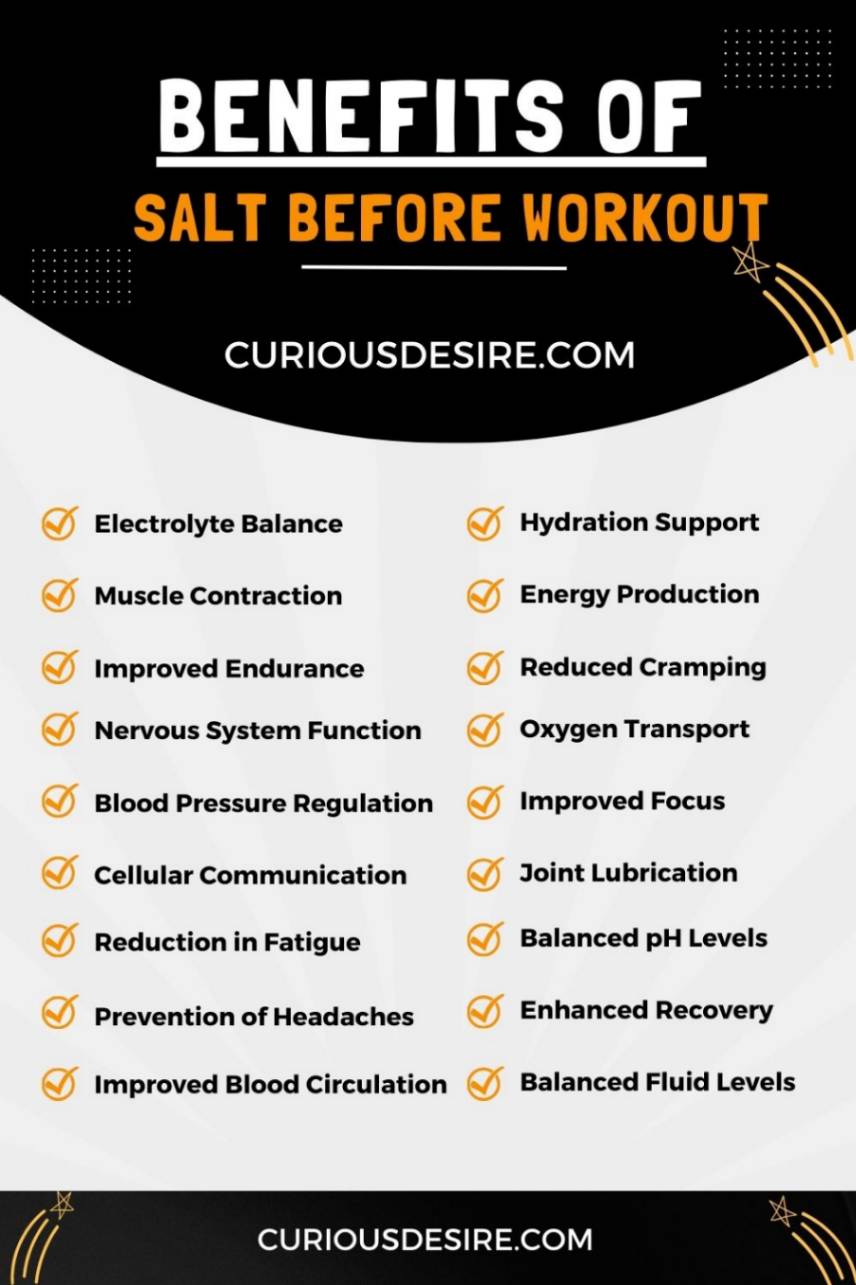Benefit 1: Electrolyte Balance
Benefit 2: Hydration Support
Benefit 3: Muscle Contraction
Benefit 4: Energy Production
Benefit 5: Improved Endurance
Benefit 6: Nervous System Function
Think of salt as the messenger that ensures smooth communication in your body, especially when you’re active. When you move, your nerves send signals to your muscles, telling them what to do.
Sodium ions step in during this transmission, ensuring the messages are relayed efficiently. It’s like having a well-coordinated dance where everyone knows the steps.
This ensures that your muscles get the right signals, improving coordination, reaction time, and overall efficiency during physical activity.
So, salt isn’t just adding flavor – it’s like the maestro conducting a symphony of movements in your body, making sure everything plays in harmony.
Benefit 7: Reduced Cramping
Imagine salt as the superhero that swoops in to save the day during your workout, preventing those pesky muscle cramps. When you exercise, your body loses salt through sweat, and if you don’t replenish it, you risk an electrolyte imbalance.
It’s like having the right ingredients for a recipe – sodium and potassium are important for the muscle contraction process.
If you’ve had a balanced meal or a sports drink with some salt before your workout, it’s like making sure your muscles have the necessary elements for smooth functioning.
Benefit 8: Blood Pressure Regulation
Picture sodium as the traffic controller for your blood flow, ensuring a smooth and steady journey for each drop. When you exercise, your heart pumps harder, and having the right amount of salt is like having well-regulated traffic lights.
Proper salt levels help keep your blood vessels at the right tension, just like keeping the roads in good condition for traffic.
This is important for your cardiovascular health – it ensures that blood flows optimally, delivering nutrients and oxygen to your hardworking muscles and vital organs.
It’s like paving the way for a well-organized traffic system in your body, supporting a smooth and efficient workout.
Benefit 9: Oxygen Transport
Think of salt as the facilitator ensuring a smooth delivery system for oxygen to your muscles during a workout. Sodium, a key part of salt, acts like a traffic director, maintaining the right balance of fluids in and around your cells.
A study found that maintaining proper sodium levels positively impacts aerobic capacity. It’s like having a well-prepared pathway for oxygen, enhancing your ability to endure and perform well during workouts.
So, salt isn’t just a seasoning; it’s like the architect designing a smooth route for oxygen, fueling your muscles for a successful exercise session.
Benefit 10: Prevention of Heat-Related Issues
Imagine salt as your body’s air conditioner during exercise, especially when it’s hot. Sodium, a superhero part of salt, acts like a cooling system, ensuring that your body doesn’t get too hot.
This helps you sweat effectively, just like turning on the air conditioner to cool down a room. Now, here’s how it prevents a heart attack: when your body overheats, it puts extra stress on your heart.
Adequate salt intake, by maintaining a cool and comfortable workout environment, reduces this stress, lowering the risk of a heart attack during exercise, especially in hot weather.
So, salt isn’t just a flavor enhancer; it’s like your body’s cooling system, keeping you safe and comfortable, even on the hottest workout days.
Benefit 11: Improved Focus
Salt contributes to improved focus during workouts by ensuring optimal nerve signaling and neurotransmitter function. Sodium ions play an important role in neural communication, enhancing cognitive function and concentration.
With proper salt levels, the nervous system functions efficiently, allowing individuals to maintain mental clarity and focus on their exercise routines.
In everyday terms, it’s similar to having a good night’s sleep before an important day – with sufficient salt levels, your nervous system works efficiently, promoting mental clarity and enabling you to stay focused.
Benefit 12: Joint Lubrication
Salt supports joint lubrication, important for reducing friction between bones during movement. Sodium helps maintain the synovial fluid within joints, promoting smooth articulation.
Adequate salt intake before a workout ensures proper joint function, minimizes discomfort, and supports a full range of motion, important for effective and injury-free exercise.
Benefit 13: Balanced pH Levels
Maintaining balanced pH levels is critical for optimal cellular function. Salt, particularly sodium, plays a role in regulating the body’s acid-base balance.
This is vital for preventing an overly acidic or alkaline environment, which can impact enzyme activity, nutrient absorption, and overall metabolic processes.
Why does this matter for your health? Well, just like a well-balanced recipe, maintaining the right pH ensures that enzymes – the workers in your body – can do their jobs efficiently.
It’s similar to having a clean and organized workspace; balanced pH levels support nutrient absorption and keep your metabolic processes running smoothly.
This contributes not only to better cellular function but also to overall workout performance and, importantly, long-term health.
Benefit 14: Cellular Communication
Salt is integral to cellular communication, facilitating the exchange of signals between cells.
This communication is essential for coordinating various physiological responses, including muscle contractions, enzyme activation, and nutrient transport, enhancing overall cellular function.
So, salt isn’t just a seasoning; it’s like the language that cells use to coordinate their activities, promoting optimal physiological responses and supporting a healthy, functioning body.
Benefit 15: Reduction in Fatigue
Think of salt as the superhero that fights off fatigue during your workout. Sodium, a key player in salt, acts like the sidekick supporting your nerves and muscles, ensuring they’re in top-notch condition.
Another way to look at it is like fueling up your car before a long journey – with enough salt, your body efficiently uses its energy stores, delaying the feeling of tiredness and helping you go the extra mile during your workout.
So, salt isn’t just a kitchen staple; it’s like your body’s energy booster, supporting you in the fight against fatigue during exercise.
Benefit 16: Optimized Nutrient Absorption
Salt plays a role in optimizing nutrient absorption in the digestive tract. Sodium facilitates the transport of nutrients, such as glucose and amino acids, across cell membranes.
This ensures that essential nutrients are efficiently absorbed into the bloodstream, providing the body with the fuel needed for sustained energy during exercise.
Just like a package delivery service that efficiently brings items to your doorstep, sodium in salt helps the body absorb essential nutrients into the bloodstream.
Benefit 17: Prevention of Headaches
Benefit 18: Enhanced Recovery
Salt supports enhanced post-exercise recovery by aiding in the restoration of fluid balance and electrolytes. Sodium is important for rehydration and replenishing lost minerals through sweat.
The study found that individuals who adequately replenished sodium after strenuous exercise experienced reduced muscle soreness and quicker recovery compared to those with electrolyte imbalances.
This underlines the role of salt in accelerating recovery processes, supporting overall muscle health, and allowing individuals to bounce back faster between workouts.
Benefit 19: Balanced Fluid Levels
Salt helps regulate fluid distribution in the body, preventing excessive water loss or retention. Adequate salt intake ensures balanced fluid levels, optimizing hydration status.
This is important for maintaining cellular function, supporting blood volume, and preventing issues such as dehydration or bloating during physical activity.
Benefit 20: Improved Blood Circulation
Salt, particularly sodium, is important for maintaining optimal blood circulation. Sodium influences blood volume and vascular tone, ensuring efficient nutrient and oxygen delivery to working muscles.
Improved blood circulation enhances overall cardiovascular function, supporting endurance, and maximizing the benefits of exercise.
In practical terms, this enhanced blood flow is like upgrading the efficiency of your body’s delivery service – nutrients and oxygen are transported more effectively, supporting endurance and maximizing the benefits of your exercise.
So, salt isn’t just a seasoning; it’s like the catalyst ensuring your body’s cardiovascular system operates at its best, allowing you to get the most out of your workout.



